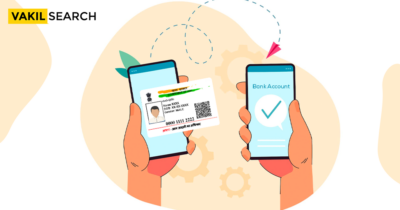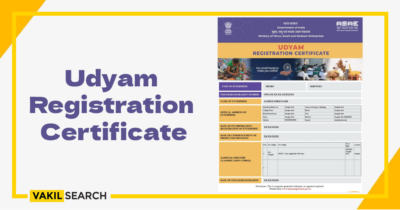In this informative article, we have stated the necessity of Udyam Registration in the context of banks and how doing so can bring a slew of benefits to you. Continue reading to learn more.
The goal of creating Udyam Registration was to smoothen the procedure that entrepreneurs and businesses undergo when it comes to registering their enterprise as MSME, or Micro Small Medium Enterprise.
The procedure for the same was a fairly time-consuming and hectic bureaucratic procedure that required the management of a larger amount of papers. Nevertheless, things have altered and, to some extent, enhanced for micro, small, and medium enterprises with the launch of Udyam Registration.
Suppose you run a micro, small, or medium enterprise and have not registered it yet. In that case, you must be aware that registering your enterprise with Udyam Registration permits you a slew of perks.
Previously, the Entrepreneur Memorandum (EM-I/II) system existed before the UAM system. Business owners used to select a heterogeneous system under this system.
A few of them depended on the national platform, and a few states had their own portal for MSME registration. Furthermore, some of them used to depend on physical paperwork.
Nevertheless, since the old system was replaced, things have changed.
What Is Udyam Registration?
The biggest question that many newbie business owners have is what exactly is the Udyam Registration. If you have the same question, you’ve come to the right spot.
Udyam Registration, also called MSME Registration, is a government registration with a certificate of recognition and a unique number. It is for the certification of medium or small enterprises.
The primary goal of launching this service was to create a means for the government to deliver maximum benefits of Udyam in India that are registered via MSME using their Aadhar Card numbers.
The entity’s proprietor, director, or owner will supply their 12-digit Aadhar Card Number. Regardless of whether the entity or enterprise is a sole owner, a private limited company, an LLP, or anything else, it’s a requirement. It must have the certificate of recognition obtained as part of the MSME registration procedure.
While firms must get Udyam Registration, the Reserve Bank of India has made it essential for lenders to guarantee that their MSME borrowers must obtain the registration. The Reserve Bank of India, in a notification (21 August 2020), made significant clarifications on its current norms and specified precisely what lenders must do.
The following article aims to offer an understanding of the clarifications mentioned above while also analysing them. Continue reading to learn more.
Udyam Registration Will Be the Acceptable Sole Evidence
Under the previous structure for MSME registration, MSME borrowers could offer either their investment proof in machinery and equipment or plant or their UAN (Udyog Aadhar Number), an EM (Entrepreneurs Memorandum) within the restrictions specified in the previous definition, together with a self-declaration that they are qualified to be categorised as an MSME. Nevertheless, because the MoM statement indicated that EM or UAN would be valid until 31 March 2021, MSMEs must register on the Udyam site per the updated criteria. As a result, lenders must collect Udyam Registration verification from new and existing borrowers by 31 March 2021.
If loans whose terms expire before 31 March 2021, the requirement mentioned above to get Udyam Registration may be waived because the borrowers’ previous registration will be valid until the loan term expires.
According to the notices mentioned above, it appears that beginning 31 March 2021, Udyam Registration will be the sole legitimate documentation for an organisation to be recognised as an MSME. In such a circumstance, it’s vital to keep in mind that a notification released by the Ministry of MSMEs on 17 July 2020 gives a list of operations for Udyam Registration that aren’t covered under the 2006 MSME Act. The following are the activities:
- Logging and forestry
- Aquaculture and fishing
- Retail and wholesale trade as well as repair of motorcycles and motor vehicle
- Wholesale trade except for motorcycles and motor vehicles
- Retail trade except for motorcycles and motor vehicles
- Household activities as domestic staff workers
- Private household undifferentiated products and services production activities for personal consumption
How Does Udyam Certificate Help to Provide Cheaper Credit?
Obtaining an Udyam Certificate has several advantages. Banks provide lower-interest loans. Lenders might also put off the collateral needs on occasion. Registration grants access to government e-tenders as well.
The registration platform is infused with numerous state government portals and the government’s e-marketplace, making it simple to obtain government tenders. You will also most likely be paid on time.
Those registered under this system are safeguarded against defaults. According to the rules, payment for services or goods should be made within 45 days.
Getting Registered as Udyam: Benefits
After registering your firm and acquiring Udyam Registration, you will be able to enjoy several benefits. The best part of getting this Registration is that the procedure is fairly straightforward, and you will not have to deal with any paperwork. Here are the top advantages:
- Registration with Udyam aids in obtaining government tenders.
- Bank loans become less expensive due to Udyam since the loan interest rates are low (up to 1.5 per cent lower compared to conventional loan interest).
- Approvals, licenses, and registration become simple, regardless of the industry or company. Enterprises registered with Idyam are given priority for government certification and permits.
- You can benefit from cheap financing at lower interest rates.
- Capital, tax, and tariff benefits are available to registered Udyams.
- Registration aids in lowering the cost of obtaining a patent or establishing an industry with the assistance of several concessions and rebates.
Linking the Disconnect
The RBI published a notification in 2017 with a set of documents to be depended on and a procedure for calculating the value of equipment and plant or machinery. According to the announcement, the buy value of the equipment, machinery, or plant will be evaluated rather than the book value. (Buy value – depreciation).
The Udyam Registration procedure, on the other hand, takes into account the value of equipment, machinery, or plant hinged on the ITR by the firm. The ITR includes the machinery value after depreciation, that is, WDV (Written Down Value).
It caused a schism between the previous RBI standards and the registration procedure. Given this disparity, the RBI issued a notification on 2 July 2020 with amended definitions and guidelines for calculating the investment in equipment, machinery, or plant, which is consistent with the MoM notification. The Reserve Bank of India has also said that the existing standards outlined in the 2017 notice will be overruled by the 2 July 2020 notification.
Conclusion
While the Reserve Bank of India has attempted to explain lenders’ positions and what they must do as a result of the shift in the description of MSMEs: https://msme.gov.in/, a few practical challenges remain, notably getting the GSTIN and PAN. The government’s motivation for delivering constant advances for MSMEs is to help the country’s small enterprises. The loan market is waiting for the government to clarify or alleviate these operational challenges. Government assistance will be a positive step toward greater financial inclusion.
Also, Read:










